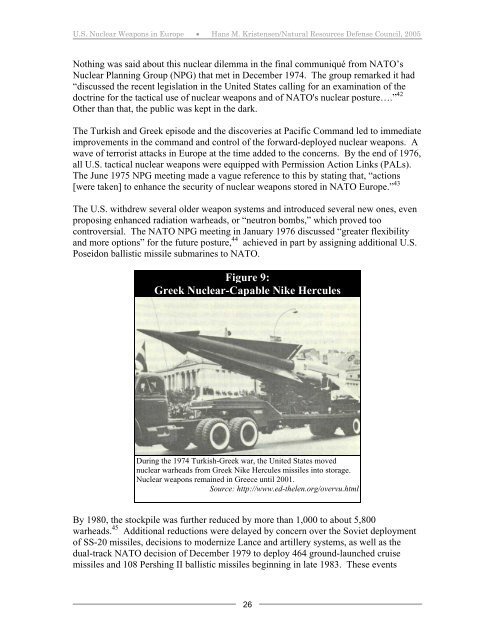US Nuclear Weapons in Europe - Natural Resources Defense Council
US Nuclear Weapons in Europe - Natural Resources Defense Council
US Nuclear Weapons in Europe - Natural Resources Defense Council
You also want an ePaper? Increase the reach of your titles
YUMPU automatically turns print PDFs into web optimized ePapers that Google loves.
U.S. <strong>Nuclear</strong> <strong>Weapons</strong> <strong>in</strong> <strong>Europe</strong> • Hans M. Kristensen/<strong>Natural</strong> <strong>Resources</strong> <strong>Defense</strong> <strong>Council</strong>, 2005<br />
Noth<strong>in</strong>g was said about this nuclear dilemma <strong>in</strong> the f<strong>in</strong>al communiqué from NATO’s<br />
<strong>Nuclear</strong> Plann<strong>in</strong>g Group (NPG) that met <strong>in</strong> December 1974. The group remarked it had<br />
“discussed the recent legislation <strong>in</strong> the United States call<strong>in</strong>g for an exam<strong>in</strong>ation of the<br />
doctr<strong>in</strong>e for the tactical use of nuclear weapons and of NATO's nuclear posture….” 42<br />
Other than that, the public was kept <strong>in</strong> the dark.<br />
The Turkish and Greek episode and the discoveries at Pacific Command led to immediate<br />
improvements <strong>in</strong> the command and control of the forward-deployed nuclear weapons. A<br />
wave of terrorist attacks <strong>in</strong> <strong>Europe</strong> at the time added to the concerns. By the end of 1976,<br />
all U.S. tactical nuclear weapons were equipped with Permission Action L<strong>in</strong>ks (PALs).<br />
The June 1975 NPG meet<strong>in</strong>g made a vague reference to this by stat<strong>in</strong>g that, “actions<br />
[were taken] to enhance the security of nuclear weapons stored <strong>in</strong> NATO <strong>Europe</strong>.” 43<br />
The U.S. withdrew several older weapon systems and <strong>in</strong>troduced several new ones, even<br />
propos<strong>in</strong>g enhanced radiation warheads, or “neutron bombs,” which proved too<br />
controversial. The NATO NPG meet<strong>in</strong>g <strong>in</strong> January 1976 discussed “greater flexibility<br />
and more options” for the future posture, 44 achieved <strong>in</strong> part by assign<strong>in</strong>g additional U.S.<br />
Poseidon ballistic missile submar<strong>in</strong>es to NATO.<br />
Figure 9:<br />
Greek <strong>Nuclear</strong>-Capable Nike Hercules<br />
Dur<strong>in</strong>g the 1974 Turkish-Greek war, the United States moved<br />
nuclear warheads from Greek Nike Hercules missiles <strong>in</strong>to storage.<br />
<strong>Nuclear</strong> weapons rema<strong>in</strong>ed <strong>in</strong> Greece until 2001.<br />
Source: http://www.ed-thelen.org/overvu.html<br />
By 1980, the stockpile was further reduced by more than 1,000 to about 5,800<br />
warheads. 45 Additional reductions were delayed by concern over the Soviet deployment<br />
of SS-20 missiles, decisions to modernize Lance and artillery systems, as well as the<br />
dual-track NATO decision of December 1979 to deploy 464 ground-launched cruise<br />
missiles and 108 Persh<strong>in</strong>g II ballistic missiles beg<strong>in</strong>n<strong>in</strong>g <strong>in</strong> late 1983. These events<br />
26
















